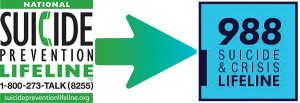- Slug: BC-CNS 988 Mental Health Hotline, 885 words.
- 2 photos and captions below.
By Alexandra Conforti
Cronkite News
PHOENIX – Mental health emergencies in the United States haven’t gotten the attention and support they require, resulting in increased suicide rates over past decades, particularly among teens, young adults and people of color.
Enter 988 – the federally mandated dialing code used to connect those in need to 24/7 suicide prevention services. A call or text to the number links individuals with trained counselors who are part of the National Suicide Prevention Lifeline network.
The Federal Communications Commission requires phone providers to make 988 accessible by July 16. The Lifeline network’s number (1-800-273-8255) will remain in operation, but the idea is to provide an easy-to-remember and faster way to get help.
“The 988 lifeline … will help thousands of people overcome crisis situations every day, and it will serve as a universal entry point so that no matter where you live, you can reach a trained crisis counselor who could help,” Health and Human Services Secretary Xavier Becerra said at a pre-rollout forum in May.
The Arizona Health Care Cost Containment System, or AHCCCS, is responsible for launching 988 in the state. An advisory committee has been assembled to guide implementation and ensure the new system meets the needs of Arizonans.
Last year, the state received a $135,000 award for planning; an additional $1.9 million grant will help the state recruit, hire and train additional 988 counselors.
One goal of the new hotline is to reduce interactions between those experiencing a mental health crisis and police, who often are dispatched to handle such situations. A study this year by the Vera Institute of Justice examined 911 calls in nine U.S. cities, including Tucson, and found about 19% involved behavioral health situations.
If trained properly, 911 dispatchers could transfer crisis calls to 988. Callers then would be connected to counselors who can provide support and resources, such as access to mobile mental health crisis teams, outpatient follow-up care, therapeutic interventions and more.
“Mental health professionals are there from beginning to end,” said Benjamin Miller, president of Well Being Trust, a national foundation working to advance the mental, social and spiritual health of individuals. “That’s a totally different process than what happens when you call 911.”
Research shows that people with untreated mental illness are 16 times more likely to be killed during a police encounter.
“Ideally, the person answering the phone (via 988) is trained to handle mental health crises,” Miller said. “They know what to say to de-escalate, they know what to say to calm and what to say to help the individual figure out what their next steps might be.”
The National Suicide Prevention Lifeline, which covers the nation with a network of more than 200 crisis centers, has received over 20 million calls since 2005. In 2020, the last year for which data are available, almost 43,000 of the 2.4 million calls were from people in Arizona. Calls to Lifeline from the state have increased 86% since 2016.
Federal officials predict that 988 could receive up to 7.6 million calls in the first year – requiring $560 million in funding to expand local and state call centers and increase training.
But longer-term funding remains a question.
So far, 21 states have enacted legislation related to 988, with several appropriating tax dollars or adding telecommunications fees to pay for services, according to the nonpartisan National Academy for State Health Policy.
There has been no proposed telecom fee in Arizona, however, and no increase in state funding to support the 988 hotline, according to AHCCCS spokeswoman Heidi Capriotti, who said the agency will further develop financial sustainability plans as 988 evolves.
Experts say more states need to take action to secure funding for years to come.
“If we want 988 to live up to its potential, it needs to be properly funded in every state,” said Molly Candon, a health economist at the University of Pennsylvania.
In 2020, Arizona spent about $158 million on crisis services, including 911, through a combination of federal funds and money from the state general fund. In addition to the new 988 line, 23 other crisis lines operating in the state will be consolidated into a single statewide 800 number by October.
Beyond funding, some advocates question whether states have enough resources and counselors in place to support 988. One concern is a lack of mental health specialists trained to work with people of different races and ethnicities, or with LBGTQ people.
Among racial and ethnic groups, Native Americans have the highest suicide rates in the nation. Suicide is also a growing crisis in the LGBTQ community; about 45% of LGBTQ youth considered attempting suicide in the past year, according to a survey this year by The Trevor Project, a national organization fighting suicide among LGBTQ youth.
Federal officials have partnered with The Trevor Project on 988 implementation and are developing training resources to help crisis counselors work with other high-risk populations, including Native Americans, Black youth and people in rural areas.
“Cultural competency is a core part of the 988 legislation,” Candon said. “Having a shared, lived experience with counselors can be incredibly powerful.”
More than a helpline, 988 is an opportunity to rethink approaches to mental health, substance use disorders and suicide prevention, Candon said, including expanding the reach of mobile crisis response teams or opening urgent care facilities that specialize in behavioral health.
“My hope is that 988 will help improve the crisis continuum at large,” she said. “My fear is that we won’t prioritize the funding to do this.”
For more stories from Cronkite News, visit cronkitenews.azpbs.org.
^__=

